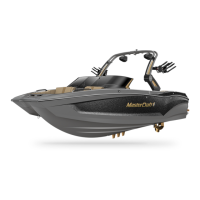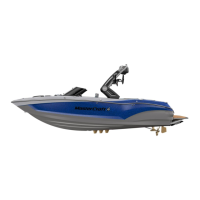Step 8: Cover the boat with a boat cover or tarp.
Note: If the boat is to be stored outside and subject to accumulations of snow, water
and ice, a support should be made for the boat cover so that it will not sag, rip or tear, thereby
allowing water to enter the boat. Two-inch diameter PVC plumbing pipe is ideal for this
purpose. It is readily available at local hardware stores, and it is easy to work with. Also, its
rounded shape will prevent damage to the canvas.
Ballast System
Preparations
Step 1: Attach a hose to
the starboard side ballast
hose that comes out of the
deck at the rear seat.
Step 2: Place the other
end into a gallon of non-
toxic,RV-typeanti-freeze.
Step 3: Turn the pump on
to empty and pump anti-
freeze into the system
until anti-freeze comes out of the thru-hull on the side.
Step 4: Turn the pump on to fill and pump anti-freeze back into the jug.
Re-Activating the Boat After Storage
Step 1: Removetheducttapefromtheexhaustaps.
Step 2: Fully charge the battery and install it in the boat, following all safety precau-
tions associated with changing batteries.
IMPORTANT NOTE: Often, batteries that have been stored over winter will require re-charg-
ing. If the battery is charged by utilizing a battery charger, use only a three-stage or more
battery charger. It is important that the operator never turn a battery charger immediately
to “start,” as the sudden jolt of voltage may cause damage to the electrical system, par-
ticularly control modules for ballast system. Regardless of whether it is during the re-acti-
vation process or at any time, care should also be used in charging the battery.
Step 3: Follow all instructions for reactivating the drive train as detailed in the engine
owner’s manual. NOTE: Due to the complex nature of the reactivation process,
MasterCraft recommends having an authorized MasterCraft dealer perform
this function.
Step 4: Ensure that all drain plugs throughout the boat and drive train have been rein-
stalled to avoid unwanted intrusion of water.
Step 5: If applicable, reconnect the hoses to your heater or shower.
Step 6: Check the engine compartment and bilge for signs of nesting animals. Clean as
necessary.
Step 7: Check the entire engine system for fluid, oil and coolant levels. Add as neces-
sary.
Step 8: Check the entire engine for cracks or leaks caused by freeze damage.
Step 9: Check all hose clamps for tightness. Install the bilge drain plug and the rear
drain plug in boats equipped with certain types of ballast systems.
Step 10: Greasethepropellershafttaperandinstallthepropeller.
Step 11: Fully re-charge and re-install the battery or batteries.
Step 12: Perform the daily maintenance as noted previously in this Owner’s Manual. If it
was not done prior to storage, perform the annual maintenance as well.
Step 13: If the boat is equipped with the optional fresh water cooling system and was
drained for storage, fill the system with fresh coolant solution per instructions.
Step 14: Check the alignment between the output flange on the transmission and the
propeller shaft flange. If the maximum feeler gauge that can clip between the
angefacesatanypointis0.003”,theunitisproperlyaligned.Ifathicker
2013 MasterCraft Owners Manual • Care and Maintenance • Page 5-32

